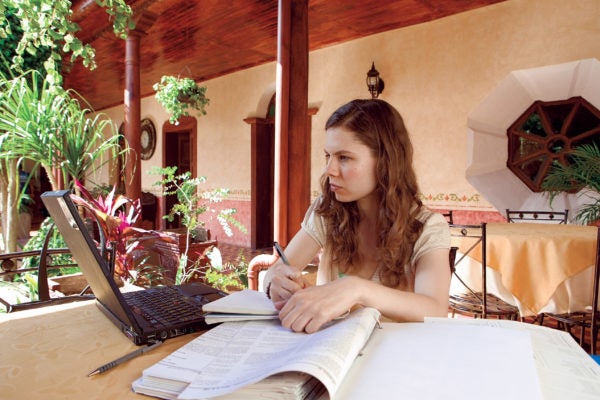Stealing art is not a victimless crime, says Therese Rohrbeck ’08
Crime scenes: A slideshow of art and the cultural heritage that is being stolen
While in Guatemala this winter, Therese Rohrbeck touched what remains of The Dream of Pope Gregory IX.
In a 2004 heist that left a security guard dead, the 17th-century painting was cut jaggedly from its frame at Antigua’s Museum of Colonial Art, leaving only strips of canvas. It’s one of hundreds of cultural artifacts that have been looted from Guatemala’s churches and museums to meet a rising demand for colonial religious art.
Rohrbeck, a 3L with a focus on cultural property law, visited the museum as part of an independent clinical project researching legal strategies for fighting the illicit trafficking of cultural heritage. During her 18-day stay, she met with officials in the Ministry of Culture and museum curators, and toured colonial churches and museums in Guatemala City and Antigua, the former capital of Spain’s nearly 300-year colonial empire in Central America.
For Rohrbeck, who has degrees in art history from Duke and the University of St. Andrews in Scotland, experiencing the art and architecture firsthand was an education in itself. She was moved by the artists’ skill and the role their work still plays in local people’s lives.
“When you see people in front of these objects, actually praying in front of them in a church, you see that it’s so much more than a representation,” said Rohrbeck. Pillaging these ecclesial objects from small churches in rural towns, she believes, is especially egregious. “People usually go to these places for a sense of connection,” she said. “It’s more than just taking a statue. It’s taking part of their faith.”
Looting also spurs the loss of a nation’s cultural identity, says Rohrbeck, who is Cuban-American and a native of Miami. “[These places] possess a history of a people that came before us and require our respect for future generations to enjoy.”
In graduate school, Rohrbeck considered pursuing a Ph.D. in art history, but after attending a talk on the legal issues in archaeology, she felt law might be the best way to bring together her interests in history, archaeology and social advocacy.

During her 1L summer, she joined the Harvard-Cornell Archaeological Exploration of Sardis in western Turkey. It was her second such trip—she worked at an Early Iron Age and Archaic site in eastern Crete after graduating from Duke. At Sardis, instead of excavating, she researched the repatriation of Turkish artifacts and cataloged finds from the dig.
While in Turkey, Rohrbeck met a Boston University anthropologist with expertise in Mesoamerican archaeology, and in the fall she worked with her to create training materials for U.S. customs officials to help stop antiquities trafficking—the first in a series of independent clinical projects that eventually led Rohrbeck to Guatemala.
After immersing herself in the 1970 UNESCO Convention on the Means of Prohibiting and Preventing the Illicit Import, Export and Transfer of Ownership of Cultural Property and the Cultural Property Implementation Act, she began a research project on the feasibility of a Guatemala-U.S. agreement, which would create U.S. import restrictions on colonial artifacts. Rohrbeck, who describes her grasp of Spanish as “functional,” spent months in Harvard’s international law library translating Guatemala’s cultural property legislation.
During her winter meeting with the director of Guatemala’s unit on illicit trafficking of cultural property, she was surprised to learn the country has not declared national ownership of its colonial art—as it has for its pre-Columbian artifacts. She says this will complicate repatriation, but Guatemala should still petition the U.S. for import restrictions.
Rohrbeck will be submitting her research paper to the U.S. State Department and Guatemala’s Ministry of Culture this summer. In the fall she will be an associate in the corporate law department at Goodwin Procter in Boston. She’d also like to gain some experience in trusts and estates, tax law and perhaps even litigation—specialties that have applications to the world of art.
Ultimately, through her writing and legal work, Rohrbeck wants to be a voice for these objects—so they are respected not just as beautiful pieces, but as pieces of history.
